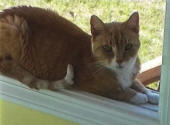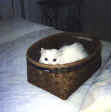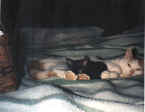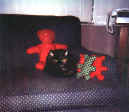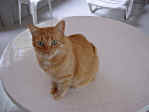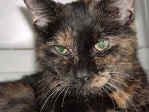|
HOUSEHOLD CHEMICALS, ENVIRONMENTAL CONTAMINANTS & DEAD CATS This is one of those articles that's a bit tough to write, but which I thought you and your pet(s) deserved to have the benefit of. Back in the fall of 1998, we lost 3 cats within 7 days and 5 cats within just a few months. This article exposes some of what we and a team of veterinarians believe might have been the cause(s). It is dedicated to our 5 dear cats. Background When we'd constructed the original add-on for our rescued cats, we were actually living at our previous home, so the animals were not at the farm. But, given that we'd sold the previous home a few years before, the rescue space at the farm was now full of cats, so they were there during the brief period it took to adapt the previous home office space for use with cats. Modifications Problems Begin To Arise The ones who kept declining included our second cat, Peaches, who was the Alpha Cat of our population, and her best buddy, Sanibel. A third cat, Iris, never showed any symptoms. I'll skip all the tests and trips to the vet, both during regular hours and at 3am some 40 miles away at a really good 24-hour clinic, but suffice it to say that we really went through a lot in the weeks leading up to the first 3 cats' demise. You can imagine how distraught, worn out and helpless we felt. Peaches had developed liver failure, kidney failure and pulmonary edema due to cardiomyopathy (loss of heart muscle function; this often is accompanied by a thickened heart wall and makes fluid collect in the lungs due to loss of pumping power), all of which were responding to treatment, but she was still looking worse and worse, losing even more weight and at times refusing to drink. She began to want to be by herself and to bury her head, which is a REAL red flag in a cat that they are nearing the end of their rope. More on Peaches in a moment. While we were dealing with Peaches, we also were going through many of the same things with Sanibel, a Tortie we'd rescued back in the late '80s. Sanibel had been under treatment for Inflammatory Bowel Disease (IBD) for some time, but it was well controlled with periodic steroid injections and at times oral steroids. Yet she began a decline, too, and ultimately ended up not wanting to be messed with, slept with, etc. She kept getting worse and began to exhibit severe lung congestion that wasn't responding to treatment. Her lab numbers got worse and worse and there were many middle-of-the-night trips to the far-away 24-hour clinic. We finally decided that euthanasia was the only thing that was going to help Sanibel feel better and put her down on October 7th, 1998. During the week after Sanibel's death, her best buddy Peaches got even worse...and it wasn't just because she missed Sanibel. X-rays showed that the edema in her lungs, which had been seemingly improving, now appeared to be blood being dumped by an artery. As could be expected when this happens, her red blood count went down to 13, a number so phenomenally low that it may as well have been zero. To take a closer look, we decided to perform an ultrasound on Peaches, but when the vet tech shaved her side and chest for the ultrasound, a 3" purplish subcutaneous circle appeared. The vets immediately aspirated the clearly palpable tumor underneath (meaning they inserted a very fine, relatively painless needle into the mass to take a biopsy). A few minutes later, we all examined the cells under the microscope and they confirmed what we'd feared: the cells were highly malignant. Just for peace of mind, we went ahead and performed the ultrasound and it showed that what we'd thought was edema in her lung was actually a 1.5" tumor surrounded by blood being dumped by her artery. I fed Peaches some more highly-palatable wet cat food (she had always LOVED to eat; you never heard a cat so vocal when there was wet food or people food around), spent a few minutes with her, shot a little video of her one last time, then our main veterinarian & I euthanized her right there on the "sheepskin" in her cage. The Truth Begins To Sink In Not Again Scratching Our Heads What We Now Believe Went Wrong When you install vinyl flooring, you use flooring adhesive that's quite odorous. To remove the excess adhesive and clean up all the marks you make on the vinyl while installing it, you use mineral spirits. When you install drywall, you have to cut it, which releases dust from the drywall. When you finish drywall, you use drywall mud which has to be sanded smooth and obviously releases dust into the air. Drywall dust contains silica, which has been proven carcinogenic. When you install baseboard and shoemold in an environment where there will be animals, you caulk it carefully with silicone caulk, which is quite odorous. When you paint an animal-oriented space, you might use the special type of paint that we did, which was then melamine-based (but isn't now). It is our belief that one or more of these factors—undoubtedly, in our and our vets' opinions, in conjunction with the fumes from the cleaner we had used for a few months—contributed to our animals' demise. We thought the nightmare was over. It STILL wasn't. Two More Previously Healthy Animals Go
Down There, our two main vets immediately put Chester on oxygen and he actually improved a bit. The quickly put him on the x-ray table and shot some films of him to see if there might have been an obstruction in his airway, but the films showed that there was none. Our main veterinarian stabilized Chester as best he could and, after much brief-but-intense discussion with us, decided that it was worth the gamble to quite lightly sedate Chester and to pass an endoscope down his trachea to take a look. The vet did this, but saw nothing abnormal...except that the flap that covered Chester's windpipe (which closes automatically so that swallowed food would go down the esophagus, not the windpipe) wasn't acting right. The vet noted that he could open the windpipe with the scope, but that it wouldn't stay open on its own. Chester's own body was suffocating him. Much further discussion followed. It was decided that we should keep the breathing tube in Chester, but gently bring him out of the anesthesia to see how he acted. He came around and was able to breathe normally without an oxygen mask, but with the tube still inserted. Obviously, an animal or person who wakes up with a breathing tube inserted is NOT going to be happy about it, so we only allowed Chester to breathe this way for a very short time before we extubated him (removed the tube). We stayed there for another hour and a half or so so we could all observe Chester, who by now was actually breathing ok on his own. He seemed to not be in distress, so after further discussion we and our vets decided that we should take him home. It was decided, though, that if this acute episode were a fluke, Chester could go on and be fine, but that if this episode were indicative of a problem that was going to recur, Chester would have no quality of life and would simply be unable to eat or breathe correctly. To prepare for the worst, the vet inserted an IV catheter into one of Chester's front legs, capped it off, and gave us the syringes of euthanasia solution. (Important Note: this is technically illegal to do, but given our decades of experience and Julie's being an ICU nurse, plus the possibility that Chester could suffocate and die a horrible death, the vet agreed to provide the solutions to us that one time.) We put Chester carefully into the car and made the drive home, during which he did fine. When we got home, we moved all the other cats out of their sunroom, which had windows all around and skylights. We put Chester there and he immediately jumped up into a chair and curled up to sleep in the sun. Julie stayed with him for awhile and I went to lie down to collect my thoughts; Chester slept peacefully, so Julie went to lie down for a bit, too. After a short time, she thought she'd go check on Chester and as she approached the cat quarters, could hear Chester gagging. She yelled for me and I came running. We uncapped the IV and euthanized Chester right there in the sun. Now we had lost 4 previously healthy cats in just a few months. More Of The Same Epilogue Note Added 3/03: Our eldest cat, Skippy, passed away in February 2003 of diabetes, cardiomyopathy and renal insufficiency, none of which was related to the issues talked about in this document. However, we did lose two other cats in ways that we believe stand a chance of being related. One was our cat Sophie, who was our eldest after the passing of Linus and Skippy. The short version of Sophie's story is that she developed lung cancer and sublingual squamous cell carcinoma. In addition, during the last week of her life, Sophie either became bowel obstructed or developed other problems that may have been cancer-related. Obviously, none of us can know for sure if Sophie's demise had anything to do with the issues raised in this document, but we believe there is a chance that there was a correlation. Another was our kitty, Tony, who spent a little time in the cattery at our farm. Tony had always been happy and healthy and we adopted him to a great couple on Indy's northeast side around Christmas of 2002. Unfortunately, during March of 2003 Tony suddenly became ill with what appeared to have been neurological symptoms. His new family spoon fed him and helped him to the litter box for a few days, but Tony took an acute turn for the worse and suddenly passed away as the family rushed him to an area clinic. A post-mortem exam showed nothing amiss, but given that Tony had been so healthy 'til then...and given his symptoms' similarity to those of Chester, we believe there's a chance that Tony's demise may have been related to the others'. What
About Our
New
Facility? We no longer use the potentially offending products in our facility, nor will I ever do any type of construction or use chemicals while there are animals nearby. We urge you not to perform construction, especially drywall, with your animals sharing the space. Our spirituality being what it is, we firmly believe that everything happens for a reason, so we're hoping that you can somehow learn from our horrible experiences and improve your animals' chances at having long, happy and, most importantly, healthy lives. P.S. You may be wondering what we now use for cleaning at our facility. Prior to the debacle described above, we'd for years used Dow Brand Foaming Bathroom Cleaner (which is pictured in our educational document about cleaning up cat barf off any color carpet, even white) and had never detected any problems with it, so that's exclusively what we use now and have literally bought thousands of cans of it over the years. So, wherever you are in our rescue facility, you're never far away from a roll of paper towels and a can of foamy cleaner. For bigger cleaning jobs, we use a mop and either bleach (once in a while) one of the liquid cleaners like Mr. Clean or Lysol, and are quite sure to rinse well. Of course, we also use DooDoo Voodoo on a daily basis and most often mop with just it in some warm water. Julie and the cat nannies will also sometimes use Clorox Cleanup spray cleaner, which contains bleach and comes in a white, orange and green spray bottle; this is especially useful for sanitizing the litter boxes every so often, but is a bit too caustic, in our opinion, for constant use (it can cause coughing). We've had no further problems except those related in the note added after the Epilogue above. Here are pictures of (left to
right): Peaches, Chester, Iris (the kitten) and Betsy, Sanibel, Tony, Miss
Kitty, Sophie and Skippy. We miss them all, think of them often and take
comfort in knowing that they'll greet us again one day. To read more about
some of the animals who have passed over the Rainbow Bridge,
click here.
|
